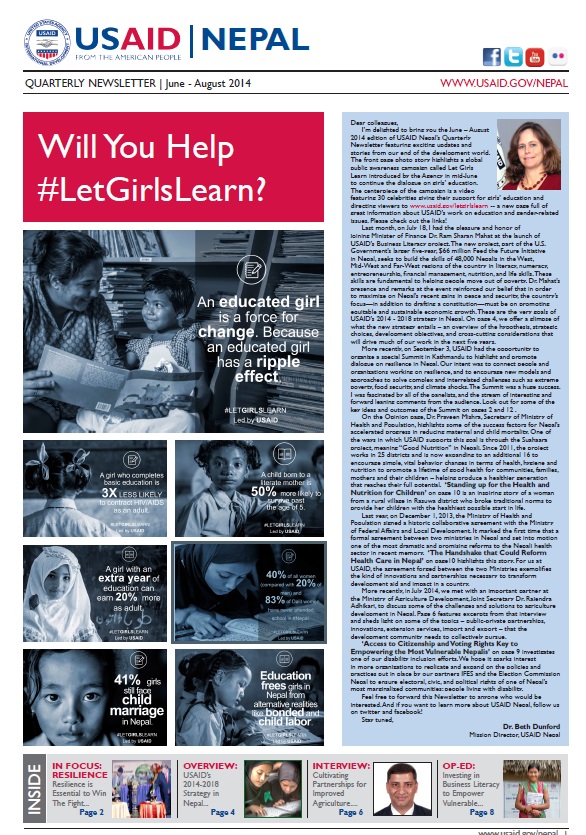Speeches Shim
Dear colleagues,
I’m delighted to bring you the June – August 2014 edition of USAID Nepal’s Quarterly Newsletter featuring exciting updates and stories from our end of the development world. The front page photo story highlights a global public awareness campaign called Let Girls Learn introduced by the Agency in mid-June to continue the dialogue on girls’ education. The centerpiece of the campaign is a video featuring 30 celebrities giving their support for girls’ education and directing viewers to www.usaid.gov/letgirlslearn -- a new page full of great information about USAID’s work on education and gender-related issues. Please check out the links!
Last month, on July 18, I had the pleasure and honor of joining Minister of Finance Dr. Ram Sharan Mahat at the launch of USAID’s Business Literacy project. The new project, part of the U.S. Government’s larger five-year, $66 million Feed the Future Initiative in Nepal, seeks to build the skills of 48,000 Nepalis in the West, Mid-West and Far-West regions of the country in literacy, numeracy, entrepreneurship, financial management, nutrition, and life skills. These skills are fundamental to helping people move out of poverty. Dr. Mahat’s presence and remarks at the event reinforced our belief that in order to maximize on Nepal’s recent gains in peace and security, the country’s focus—in addition to drafting a constitution—must be on promoting equitable and sustainable economic growth. These are the very goals of USAID’s 2014 - 2018 strategy in Nepal. On page 4, we offer a glimpse of what the new strategy entails – an overview of the hypothesis, strategic choices, development objectives, and cross-cutting considerations that will drive much of our work in the next five years.
More recently, on September 3, USAID had the opportunity to organize a special Summit in Kathmandu to highlight and promote dialogue on resilience in Nepal. Our intent was to connect people and organizations working on resilience, and to encourage new models and approaches to solve complex and interrelated challenges such as extreme poverty, food security, and climate shocks. The Summit was a huge success. I was fascinated by all of the panelists, and the stream of interesting and forward leaning comments from the audience. Look out for some of the key ideas and outcomes of the Summit on pages 2 and 12 .
On the Opinion page, Dr. Praveen Mishra, Secretary of Ministry of Health and Population, highlights some of the success factors for Nepal’s accelerated progress in reducing maternal and child mortality. One of the ways in which USAID supports this goal is through the Suahaara project, meaning “Good Nutrition” in Nepali. Since 2011, the project works in 25 districts and is now expanding to an additional 16 to encourage simple, vital behavior changes in terms of health, hygiene and nutrition to promote a lifetime of good health for communities, families, mothers and their children – helping produce a healthier generation that reaches their full potential. ‘Standing up for the Health and Nutrition for Children’ on page 10 is an inspiring story of a woman from a rural village in Rasuwa district who broke traditional norms to provide her children with the healthiest possible start in life.
Last year, on December 1, 2013, the Ministry of Health and Population signed a historic collaborative agreement with the Ministry of Federal Affairs and Local Development. It marked the first time that a formal agreement between two ministries in Nepal and set into motion one of the most dramatic and promising reforms to the Nepali health sector in recent memory. ‘The Handshake that Could Reform Health Care in Nepal’ on page10 highlights this story. For us at USAID, the agreement forged between the two Ministries exemplifies the kind of innovations and partnerships necessary to transform development aid and impact in a country.
More recently, in July 2014, we met with an important partner at the Ministry of Agriculture Development, Joint Secretary Dr. Rajendra Adhikari, to discuss some of the challenges and solutions to agriculture development in Nepal. Page 6 features excerpts from that interview and sheds light on some of the topics – public-private partnerships, innovations, extension services, import and export – that the development community needs to collectively pursue.
‘Access to Citizenship and Voting Rights Key to Empowering the Most Vulnerable Nepalis’ on page 9 investigates one of our disability inclusion efforts. We hope it sparks interest in more organizations to replicate and expand on the policies and practices put in place by our partners IFES and the Election Commission Nepal to ensure electoral, civic, and political rights of one of Nepal’s most marginalized communities: people living with disability.
Feel free to forward this Newsletter to anyone who would be interested. And if you want to learn more about USAID Nepal, follow us on twitter and facebook!


Comment
Make a general inquiry or suggest an improvement.